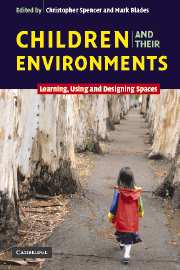Book contents
- Frontmatter
- Contents
- Notes on contributors
- An introduction
- Part I Children's understanding of places
- Part II Children's experience of places
- Part III Adolescents' worlds?
- 10 On the other side of the tracks: the psychogeographies and everyday lives of rural teenagers in the UK
- 11 The socio-environmental affordances of adolescents' environments
- Part IV Children and the design process
- Index
- References
11 - The socio-environmental affordances of adolescents' environments
Published online by Cambridge University Press: 23 October 2009
- Frontmatter
- Contents
- Notes on contributors
- An introduction
- Part I Children's understanding of places
- Part II Children's experience of places
- Part III Adolescents' worlds?
- 10 On the other side of the tracks: the psychogeographies and everyday lives of rural teenagers in the UK
- 11 The socio-environmental affordances of adolescents' environments
- Part IV Children and the design process
- Index
- References
Summary
Introduction
Whilst children's environments have been comprehensively researched and reported in environmental psychology, adolescents' use and evaluation of their environments have received virtually no attention; we believe this to be the first review of its kind. This chapter attempts to provide a theoretical framework for examining and explaining the meaning and function of four salient environments for adolescents – the home, school, neighbourhood and town/city centre. Furthermore, this chapter focuses on the function of these environments for the realization of social interaction and retreat opportunities. The theoretical framework has been informed by, but also tries to move forward from, Gibson's (1979) theory of affordances and Heft's later application of Gibson's ideas to outdoor environments (Heft, 1988, 2001). The significant contribution of this study is that it articulates and makes the case for a more socially-driven concept of affordances. The chapter concludes by reporting briefly on recent research undertaken in the UK (Clark, 2001; Clark and Uzzell, 2002) which sought to measure the socio-environmental affordances of the environment and their implications for adolescent behaviour.
Environmental perception – Gibson's theory of affordances
The issue of environmental perception, and more specifically, social perception, lies at the heart of any attempt to evaluate the function of the environment. In order for an individual to be able to interact with the environment they have to be able to perceive its social meaning.
- Type
- Chapter
- Information
- Children and their EnvironmentsLearning, Using and Designing Spaces, pp. 176 - 196Publisher: Cambridge University PressPrint publication year: 2006
References
- 35
- Cited by



